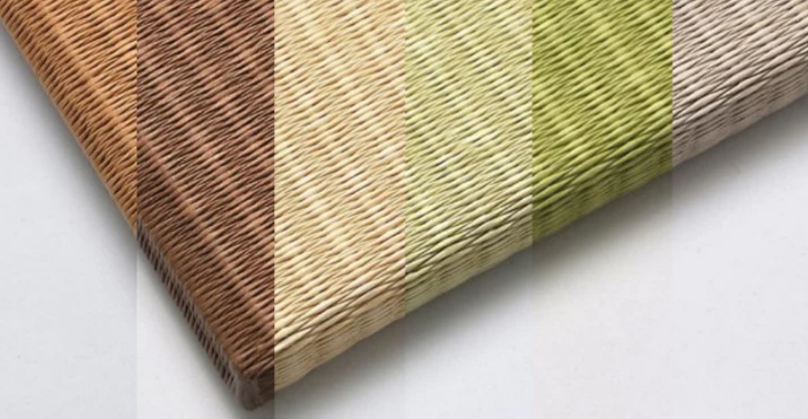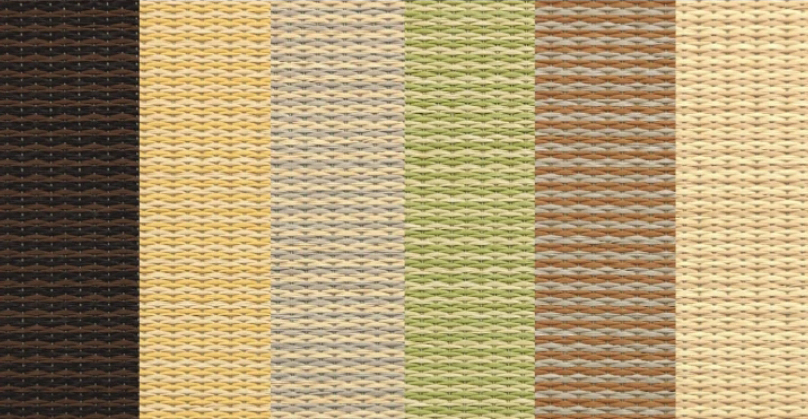What is a Tatami Mat? A Guide to Traditional vs. Modern Styles

In recent years, the rise in interest in Japanese minimalist interior design, along with the growing popularity of Japandi style, has brought renewed attention to tatami mats, a key element in these aesthetics. Traditionally, tatami mats are a staple in Japanese-style rooms (Washitsu) but incorporating them into wood-floored homes in the U.S. has often been challenging. This is due to the need for substantial changes in the overall design of such living spaces.
However, a new type of tatami mat has been developed to overcome these hurdles, allowing easy installation in Western-style homes while preserving the traditional feel and benefits of conventional tatami. These modern “Tatami mats” have a fascinating origin that ties back to the evolution of Japanese living spaces. After World War II, Japan saw a gradual shift from traditional Washitsu to Western-style wood-floored rooms, influenced in part by American culture. As this change became more widespread, there was a nostalgic longing for the comfort and simplicity of tatami rooms, though remodeling homes to include them was often costly and impractical.
This led to the creation of the new “Tatami mat”—a simple solution that allows homeowners to bring a touch of traditional Japanese style into their modern, wood-floored spaces without major renovations. These mats are designed specifically to meet the needs of Western-style homes, making it easier to introduce the essence of Japanese design into everyday American living.
While the term “tatami” has become more recognized in the U.S., the distinction between traditional tatami and these newer tatami mats isn’t widely understood. In this article, we’ll explain the key differences between conventional tatami, which have been a part of Japanese homes for centuries, and modern tatami mats, which have been adapted for contemporary Western interiors.
INDEX
- What do you mean by so-called “conventional tatami”?
- Differences between conventional tatami and modern tatami mats
- Which tatami mats are best suited for Western-style rooms?
- Conclusion
What do you mean by so-called “conventional tatami”?

As we discussed in a previous article (see: About the History of Tatami – From Its Origins to Modern Trends), tatami has a rich history spanning over 1,300 years. For many, the image of a Japanese-style room with tatami—a surface made from rush grass and bordered with dark-colored fabric—evokes memories of classic period dramas set in Japan. If you’re a fan of such films or shows, you might recall the Emmy Award-winning series “SHOGUN,” which featured scenes set in a castle with tatami floors. The floor where Hiroyuki Sanada and Anna Sawai performed one of their memorable scenes is what we refer to here as “conventional tatami.”
What’s fascinating is that the tatami you see in historical dramas like SHOGUN is still in use in many modern Japanese homes. Despite Japan’s embrace of Western-style architecture, traditional tatami rooms remain a common feature in many households today. For more insight into this, check out our blog post 6 Must-Visit Destinations in Japan to Experience Authentic Tatami Rooms # Japanese-style room in an ordinary home, where we explore modern homes that still incorporate these timeless spaces.
Differences between conventional tatami and modern tatami mats
Now that you’re familiar with conventional tatami, let’s take a closer look at how they compare to the newer tatami mats that have recently hit the market. While there are some differences, the two actually share a lot in common. Let’s start by exploring their similarities:
- Tatami Surface Material
Traditional tatami is made using igusa (rush grass) for the surface. Modern tatami mats, however, can also use materials like Japanese paper or resin in addition to rush grass, depending on their purpose. Interestingly, some conventional tatami also incorporates these newer materials, so at this point, there isn’t a significant difference in the materials used for both.
- Shape
Conventional tatami is typically rectangular, although square versions, like Ryukyu tatami, also exist. Modern tatami mats, on the other hand, are usually square, but rectangular versions are available too. In Japan, the square shape has become the more popular image of “modern tatami mats.”
- Edges (Heri)
Traditional tatami often has cloth edges, called heri (縁), sewn along the longer sides for reinforcement. Most modern tatami mats are edge-free, though some still feature edges like the conventional ones.
In summary, while modern tatami mats have been designed with Western spaces in mind, they retain many similarities with traditional tatami, especially in terms of materials, shapes, and even edges.
So far, we’ve highlighted the shared features of conventional tatami and modern tatami mats, but now let’s focus on the key differences between them.
-
Color Options
One of the biggest differences is the variety of colors available with modern tatami mats. Unlike traditional tatami, which comes in the familiar green hue of rush grass, modern tatami mats—made from materials like Japanese paper and resin—are available in a wide range of colors. This was intentional, as these mats were designed to blend seamlessly into Western-style interiors. To give you an idea, here are some of the color variations we offer, and you’re sure to find a shade that perfectly complements your personal interior style.
Tatami Mat – Seiryu

Tatami Mat – Saien

-
Thickness
Another key difference is the thickness. Conventional tatami mats are typically around 55mm to 60mm thick, whereas modern tatami mats are much thinner, usually about 15mm. Despite being thinner, modern tatami mats do not sacrifice any of the cushioning properties of conventional tatami. In fact, their thinner design brings added advantages—they’re easier to carry, store, and move around, allowing you to change your interior decor with the seasons more easily.
-
Installation Labor
One of the biggest challenges with conventional tatami is the installation process. Traditional tatami mats are designed to be laid evenly over a prepared floor base, which requires a specific construction style. This is often a major hurdle for incorporating tatami into U.S. homes, as it either requires a Japanese-style room to be included in the original design of the house or a costly remodel to install them afterward. The thicker design of traditional tatami also ties into this method of installation. In contrast, modern tatami mats are much easier to install, making them a more practical option for Western homes.

On the other hand, modern tatami mats are specifically designed for use in wood-floored rooms, so they can be installed as easily as laying down an ordinary mat—no special construction is needed. If you’re concerned about the mats slipping on the floor, there’s no need to worry, as the backing is made with a non-slip surface. Just keep in mind that if the flooring is uneven, it may reduce the effectiveness of the non-slip backing.

Which tatami mats are best suited for Western-style rooms?
So far, we’ve explored the similarities and differences between conventional tatami and modern tatami mats in detail. By now, I hope you have a clearer idea of which option might be right for your home. In conclusion, unless you’re planning a full-scale remodel to create a traditional Japanese-style room, we recommend starting with modern tatami mats to create a modern Japanese aesthetic in your interior.
Modern tatami mats are not only easier to install, but they were also specifically designed to blend seamlessly with Western-style interiors, making it simple to achieve a modern Japanese look at home. To enhance this style, we suggest using square tatami mats without edges, as they offer a more contemporary feel. Rectangular mats with edges have a stronger traditional Japanese look, which can be harder to incorporate into Western-style spaces.
One of the pleasant surprises of using square tatami mats is how the alternating angles of the tatami’s grain can create a natural checkerboard pattern, thanks to the way the light reflects off the mats. This effect, created by the natural light flowing into your space, complements the Japandi style, which emphasizes a connection with nature. You can even take this effect further by alternating different-colored mats to create your own unique pattern, adding another layer of sophistication to your interior.

Here are some examples of how you can use modern tatami mats to create a beautiful, modern Japanese space in your home. While these are just a few ideas, there are countless other ways to incorporate modern tatami mats, so feel free to use these examples as inspiration and explore different ways to craft your ideal Japanese-inspired interior.
- Create a Japanese modern space in a corner of the living room

Tatami mats shown here can be purchased here.
- Create a children’s play area space.

Tatami mats shown here can be purchased here.
- Create a special space by setting up a raised area.

Tatami mats shown here can be purchased here.
Conclusion
In this article, we’ve explored the differences between conventional tatami and modern tatami mats, highlighting why the new type of tatami mats are an excellent choice for bringing a touch of modern Japanese style to Western interiors. What do you think? We hope this information helps you in your search for tatami mats!
To summarize, modern tatami mats can be described as “a new generation of tatami that easily fits into Western-style rooms with wood flooring while maintaining the authentic atmosphere of traditional tatami.” However, since modern tatami mats have only recently entered the market, their naming can be a bit unclear, even in Japan. Terms like “oki tatami,” “unit tatami,” and “flooring tatami” are often used synonymously with modern tatami mats. In the U.S., both conventional and modern tatami mats are generally referred to as “tatami mats,” which can lead to confusion for those trying to find the right type.
If you have questions or need guidance in selecting the perfect tatami for your space, don’t hesitate to reach out to us at Interra USA. We’re here to help you find the ideal tatami solution tailored to your needs.
That wraps up this issue! Stay tuned for our next article, where we’ll delve into another topic perfect for anyone interested in Japanese-style interior design.
Reference link:
置き畳ってどんな畳?普通の畳との違いについても紹介! | 畳のミカタ.com
置き畳と和室の畳の違いは?
和室の畳と置き畳の違いは何ですか? – YouTube
置き畳のメリット・デメリット!フローリングで使うポイントを解説 – ラグ・カーペット通販【びっくりカーペット】
畳とフローリングどっちがいいの?メリット・デメリットをまとめました。
置き畳商品開発者が本気で選ぶ!おすすめ置き畳10選。選び方のポイントもご紹介 – イケヒコのインテリアブログ
畳の種類まとめ 素材の違いや選び方、伝統的なスタイルから和モダンに合う製品 – DAIKEN – 大建工業
置き畳|工場直販の畳通販専門店 たたみのこうひん [公式]
琉球畳と置き畳の違い
置き畳でフローリングの部屋に和室空間を!メリット・デメリットと設置のポイント – &ART
置き畳をフローリングに設置するメリットデメリット│選び方も紹介 – くらしのマーケットマガジン

